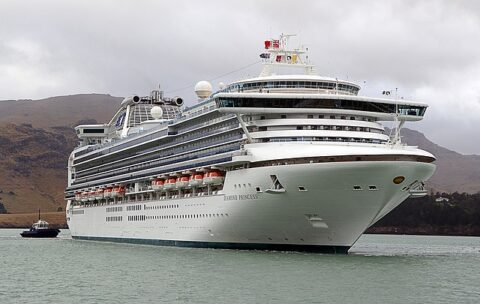The Historian’s Craft
Published 9 Feb 2023Hoplites are probably one of the first things that come to mind when one thinks of “Ancient Greece”. Equipped with a bronze spear and wearing bronze armor or a linothorax, and hefting the aspis — the hoplite‘s bronze shield — they fought in phalanxes. The classic mode of fighting in this formation was the “othismos“, the push, with the aim being to disrupt the enemy phalanx and break their formation. But, over the past few decades, views on hoplite warfare have been called into question and seriously revised, because there are problems in the source material. So, what are these problems, and how do historians of Ancient Greece understand hoplite warfare?
May 25, 2023
The Hoplite Heresy: Why We Don’t Know How the Ancient Greeks Waged War
QotD: How long does “celebrity” last?
The first warning sign was when they renamed Bob Hope Airport.
Back in the 1940s, Bob Hope was the most popular comedian in the world. He was a radio star. He was a movie star. He would later become a TV star at NBC.
When Hope died in 2003, it made perfect sense to name the Burbank airport after him. After all, his longtime employer NBC was the best known company in Burbank, and Bob Hope had spent a half-century on the network — usually at the top of the ratings.
So the local airport got renamed.
But the only thing that lasts forever in pop culture is the fact that nothing last forever. By 2017, Bob Hope was only a dim memory at NBC, and young passengers flying to SoCal had no idea who he was. So they changed the name to the Hollywood Burbank Airport.
By coincidence this happened almost exactly 80 years after Hope rose to fame — when Paramount signed him to star in the film The Big Broadcast of 1938. In that hit movie, he sang his charming theme song “Thanks for the Memories” — which he kept singing until the end of the 20th century. Not long ago, everybody knew that song.
But then the memories ran dry.
I’ve long believed that 80 years is a typical span of pop culture fame for superstars. I’m referring to the biggest names — the lesser stars burn out in 80 months or 80 weeks or 80 days. But the top draws retain their fame for the entire lifetime of their youngest fans — and given current life expectancies of the US audience, that can’t be much more than 80 years.
We already see the price of Elvis Presley memorabilia starting to drop. The recent Elvis biopic might slow the erosion, but will never bring back the King’s red hot fame of the 1950s. By my measure, Elvismania will be officially dead in the year 2034. That will be the 80th anniversary of his first hit single “That’s All Right”. Almost none of his original audience will still be around to celebrate the anniversary, and that can’t bode well, even for the nostalgia crowd.
Some reputations do flourish after 80 years, but only because the entertainers somehow found an audience outside of pop culture. Louis Armstrong was famous as an entertainer during his lifetime, but enjoys posthumous renown as an artistic and cultural figure. Back in the 1920s, Rudy Vallée sold more records than Armstrong, but never made the transition outside of pop culture.
Ted Gioia, “How Long Does Pop Culture Stardom Last?”, The Honest Broker, 2023-02-23.
May 24, 2023
The Original PB&J from 1901
Tasting History with Max Miller
Published 23 May 2023
(more…)
The American flagship of Standing NATO Maritime Group 2 (SNMG2)
CDR Salamander has thoughts on the state of the current flagship of Standing NATO Maritime Group 2 (SNMG2), USS James E. Williams … unhappy thoughts:
One of the most high profile alliance units is Standing NATO Maritime Group 2 (SNMG2).
Consisting of a half dozen or so destroyers and frigates from assorted alliance members, it cruises about refining how we work together, conducting exercises, and showing the flag around the Mediterranean and Atlantic as time and livers allow. It is also an opportunity for nations to show their allies their professionalism.
Really, for a Sailor of any nation, it is some of the best duty you can find this side of BALTOPS … but I digress. We’ll return to BALTOPS at the bottom of the post.
Because of its high profile and extended operations with alliance nations, the ships we assign to SNMG2 don’t just represent the USA as any warship that “shows the flag” does, but it imprints on the mind of military and civilian leaders in Europe the quality of the US Navy and by extension, the nation it serves.
Our opponents in the world will also see it as an indication of our general health, morale, and the respect we show our friends.
I had an interesting seat as a junior officer. A little more than a month after reporting to my first sea duty command, I found myself with a front row seat to not just Desert Shield/Storm, but to the last year or so of the Soviet Union. I then watched from the Mediterranean and Atlantic the slow decay of the now Russian naval forces through the 1990s. A common refrain was as we got a close look at them was, “Did you see the condition they’re in?”
Looks matter. With ships, even more than people, the external manifestations of poor condition are a warning of significant problems inside the skin of the ship

The Arleigh Burke-class Flight IIA guided missile destroyer USS James E. Williams (DDG 95) as it was leaving Toulon, France, May 22, 2023. Yes, the ship named after a Boatswain’s Mate First Class looks like that. I am sorry BM1, we tried.
Photo from https://twitter.com/WarshipCam/status/1660740976942501893.
SNMG2 decided to honor the United States Navy by having one of its destroyers be its flagship. That’s right kiddies; that rusting eyesore is the flagship of SNMG2.
The US Navy decided that this was the warship they wanted to represent the US Navy and the nation it serves. This was an act of commission – of intent – as conscious of an act as that which ensured that in the last few years that warship was not manned, trained, equipped, or maintained at a level which would allow for basic maintenance. Even as she got ready to get underway, no one stopped her. No one tried a last minute fix. The whole evolution has an ambiance of, “Who cares. Send her.”
Don’t think the insult isn’t properly understood, if not to Congress and the American people, but to our friends and competitors. Don’t think this isn’t the talk of allied wardrooms.
Darne Model 1933: An Economic & Modular Interwar MG
Forgotten Weapons
Published 15 Feb 2023The Darne company was one of relatively few private arms manufacturers in France, best known for shotguns. During World War One they got into the machine gun trade, making licensed Lewis guns for the French air service. After making a few thousand of those, Regis Darne designed his own belt-fed machine gun in 1917. A large order was placed by the French military, but it was cancelled before production began because of the end of the war.
Darne continued to develop this design in the 1920s, while also producing sporting arms to keep the business running. The gun was intended mostly as an aircraft gun, but designed in a rather modular fashion, easily made into both magazine-fed and belt-fed infantry versions as well as downing, wing, and observer aerial models. It was actually bought by the French Air Force, as well as several other countries during the inter-war period.
The example we are looking at today is an infantry configuration, with a bipod and light-profile barrel. It is chambered for the French 7.5x54mm cartridge, and is officially the Model 1933 (one of the last iterations made).
(more…)
QotD: Impostor Syndrome in academia
Trust me on this: “impostor syndrome” is very real. It is, in fact — and obviously — the source of the benzo bottle in every egghead’s medicine cabinet. And the reason all eggheads feel like frauds is equally obvious: Nothing you do can possibly justify your paycheck.
There are no Dead Poets Society teachers in real life in any case, and even if there were, and even if you were one of them, well … congrats, buddy, you’ve managed to reach one student, one time, out of the hundreds, thousands, tens of thousands you taught before reaching tenure, the hundreds, thousands, tens of thousands more who will drift through your classroom, fish-eyed and phone-addled, for the rest of your academic career. One kid, one time, and meanwhile you live a life that 90% of Americans would be ecstatic to have. (As for your “research”, […] please. Unless your book revolutionizes a field — good luck with that — maybe twenty people will read it, and fifteen of them will hate it). You’re a fucking fraud, pal, that’s all there is to it …
Which leaves you with two options, if you want to avoid the kind of crushing cognitive dissonance that turns a guy like Todd into a gutter drunk: You embrace the make-believe, or you quit. Todd quit. Becoming a gutter drunk was a spectacularly gaudy, self-destructive way of quitting, but it was quitting nonetheless. I quit too, as y’all know … but the funny thing was, I didn’t quit drinking until I did. I didn’t go out and get wrecked every night like I used to do with Todd, but I was still a drinker, often quite a heavy one. I just did it in private. It was only when I quit the ivory tower for good that I stopped drinking.
This, I suggest, is the ultimate source of the Poz: The crushing impostor syndrome that all Americans feel, who haven’t built their lives up from scratch. Unless your day-to-day is a struggle, a real one — a “need to choose between buying food and making rent” one — you can’t help but feel, at some level, that you’re a fraud, a sham. You don’t deserve this, because no one deserves this who didn’t earn it, didn’t hew it out of the wilderness himself. And the more “white collar” you are, the stronger your latent impostor syndrome. Is it any surprise that Karen, who has never earned anything in her entire life, is the most pozzed? That “Human Resources” is just the Poz Gestapo?
Severian, “On the Poz”, Rotten Chestnuts, 2020-11-16.
May 23, 2023
The Diamond Princess – the “worst case virus mill” during the Covid-19 pandemic
Dr. Todd Kenyon looks at the data from the situation onboard the Diamond Princess early in the pandemic:

Diamond Princess is a cruise ship owned and operated by Princess Cruises. She began operation in March 2004 and primarily cruises in Alaska during the summer and Asia in the winter along with Australia cruises. Diamond Princess and Sapphire Princess were both were built in Nagasaki, Japan by Mitsubishi Heavy Industries.
Photo by Bernard Spragg, NZ via Wikimedia Commons.
The Diamond Princess cruise ship departed Japan on January 20, 2020. Five days later a passenger disembarked, later became ill and tested positive for SARS-CoV-2 infection. On board this ship were 3,711 persons, of which 2,666 were passengers (median age of 69) and 1,045 were crew (median age of 36). Nearly half (48%) of the passengers were said to have underlying disease(s). Passengers and crew began testing positive with some becoming ill, but the passengers were not quarantined in their cabins until Feb 5. Until that time they had been engaging in a variety of typical social activities including shows, buffets and dances. Once quarantined (confined to cabins), most passengers shared cabins with 1 to 3 other passengers. Cabins used unfiltered ventilation and the crew continued their duties and mixed with passengers. Evacuation began in mid February and was completed by March 1.
A total of 712 individuals (19%) tested positive via PCR, and as many as 14 passengers were said to have died, though there are differing opinions as to how many of these deaths should be attributed to Covid. Except for one person in their late 60s, all deaths occurred in those over 70. Not one crew member died. Half of the deaths occurred several weeks after leaving the ship, so it is unclear if they actually died from infections caught onboard. Three ill passengers were given an experimental treatment of Remdesivir once hospitalised on shore; apparently all survived.
The Diamond Princess was termed a “virus mill” by one expert while another remarked that cruise ships are perfect environments for the propagation and spread of viruses. The quarantine procedures inflicted much duress on an already frail passenger base and may have done more harm than good. There was panic and confusion both among passengers and crew, and densely packed passengers sharing unfiltered ventilation were only allowed out of cabins every few days for an hour. Meanwhile the crew continued to prepare meals and mix with passengers, but otherwise were kept confined below the waterline in their cramped multi-resident quarters. Some passengers ignored the quarantine entirely. The so-called “Red Dawn” email discussions among government researchers in early 2020 described the DP as a “quarantine nightmare”. The DP was also termed by this group as representative of a large elderly care home (passengers). Based on all these observations, the DP event should provide a nearly worst case scenario for the first wave of Covid. The question is, how did New York City (NYC) fare versus this “worst case”, and what can we learn from the comparison?
We can start by looking at the infection rate on the DP: 25% of those over 60 and 9% of those under 60 were reportedly infected. On the DP, the case fatality rate (CFR) for those over 60 was 2.6%. This assumes that all 14 deaths of passengers were caused by a Covid-19 infection contracted while on the DP. On the other hand, the CFR for those under 60 years of age was 0.0%, since none in this age bracket died.
Diamond Princess mortality (scaled) compared to New York City all cause mortality. DP week 1 = first week quarantine imposed while NYC week 1 = first week of lockdown orders (week 12, 2020). DP fatalities are scaled based on relative populations of individuals over 65. It is unclear whether the DP fatalities at the tail end of the curve are attributable to C19 infection contracted months prior on the DP. NYC data: www.mortality.watch
Mustard: A Spicy History
The History Guy: History Deserves to be Remembered
Published 15 Feb 2023In 2018 The Atlantic observed “For some Americans, a trip to the ballpark isn’t complete without the bright-yellow squiggle of French’s mustard atop a hot dog … Yet few realize that this condiment has been equally essential — maybe more so — for the past 6,000 years.”
(more…)
QotD: Cavalry operations in Rings of Power versus cavalry operations in history
Now before I lay into this, fair is fair: Peter Jackson’s The Lord of the Rings had a real habit of having the horses almost always move at the trot or the canter when they ought to have been walking (horses have four “gaits” – patterns of moving – which, in escalating speed are the walk, the trot, the canter and the gallop). Horses can walk or trot for long periods, but canters and gallops can only be maintained in short bursts before the horse wears itself out. So for instance when Théoden leads the Rohirrim from Edoras in Return of the King the horses are walking in the city but by the time they’re in column out of the city the whole column is moving at a canter (interestingly, you can hear the three-beat pattern of the canter in the foley, which is some attention to detail), which is not realistic – they have a long way to go and they won’t be able to maintain this gait the whole way – but fits the forward momentum of the scene. Likewise most of the horses look to be at a canter when his army leaves Dunharrow for Gondor; again this is a bit silly, but on roughly the level of silly of having Aragorn, Legolas and Gimli pursue a band of orcs by jogging for three days and nights without rest.
By contrast [in Rings of Power], the Númenóreans rush to the battle at a full gallop, apparently the whole way or at the very least for hours through the morning. Horses will be vary, but generally two to three miles is the maximum distance most horses can gallop before fatigue sets in (for most horses this distance is going to be shorter), which they’re going to cover in about six minutes. The gallop is a very fast (25-30mph), very short sprint, yet Galadriel has this whole formation at full gallop even before she can see their destination. And I just want to remember here the absurdity that these horsemen do not even know there is a battle to ride to; for all they know this is a basic scouting effort (which might be better accomplished slowly and without wearing down all of the horses). Théoden at least has the excuse that he’s on the clock and knows it!
The way we are then shown the cavalry arriving is very confusing to me. The speed of their arrival makes at least some sense. We have already established that both Arondir and Adar are incompetent commanders so the fact that they have set no scouts or lookouts checks out. Pre-modern and early-modern cavalry could effectively out-ride news of their coming, and so show up unexpectedly in places with very little warning. Not this little warning, mind you – the time from the first sound of hoof-falls (heard by Elves – the orcs evidently hear nothing) to the cavalry deluging the village is just about fifteen seconds; horses move fast but they do not move that fast (at full gallop a horse might cover 150-200 meters in those fifteen seconds and the orcs would absolutely hear them coming before they saw them). But the idea in general that the Númenórean cavalry could appear as if out of nowhere to the orcs checks out – that was one of the major advantages of cavalry operations.
Bret Devereaux, “Collections: The Nitpicks of Power, Part III: That Númenórean Charge”, A Collection of Unmitigated Pedantry, 2023-02-03.
May 22, 2023
What Happened Behind a Photographer’s Lens on D-Day
World War Two
Published 21 May 2023Robert Capa has gone down in history as one the most groundbreaking war correspondents in all of journalism. His account of what happened on D-Day was something we wanted to share with all of you.
(more…)
Dire Straits – “Sultans Of Swing” (Old Grey Whistle Test, 16th May 1978)
Dire Straits
Published 21 Oct 2022Dire Straits performing “Sultans Of Swing” in their first ever TV performance live on BBC’s The Old Grey Whistle Test in May, 1978. This performance took place three days before the UK release of their debut single of the same name.
(more…)
QotD: Gamesmanship in golf
One of the nicest things about the game of golf is that it’s a gentle one — no bodies crashing against each other, no feats of strength, no slam-dunks or soaring home runs: just quiet, delicate and deliberate movements.
Which also applies to the subtle art of gamesmanship. No in-your-face screaming “Bring It On!” chest-thumping or trying to put your opponent off his shot; just quiet, subtle digs designed to get inside his head to make him change his game, to his disadvantage or your advantage.
I remember once mis-hitting a drive which just managed to stay on the fairway, but only went for about 150 yards — whereupon my opponent asked disingenuously: “Does your husband also play golf?” implying, of course, that I hit like a girl.
And before anyone thinks that this kind of remark is in any way demeaning to women — it isn’t, because the fact of the matter is that women can’t hit the ball as far as a man can, which is why all golf courses have a “Ladies Tee” in each hole, usually many yards closer to the fairway and green than those used by men.
So when Tiger Woods (47) surreptitiously handed his opponent Justin Thomas (29) a tampon after his drive had traveled further than the younger man’s, everyone knew exactly what he was doing: teasing Thomas, and playing a little gamesmanship.
Kim du Toit, “Growing Skin”, Splendid Isolation, 2023-02-21.
May 21, 2023
The Fall of Monte Cassino – WW2 – Week 247 – May 20, 1944
World War Two
Published 20 May 2023In Italy, the Allies finally overcome Monte Cassino and break through the Gustav Line; in Burma Merrill’s Marauders surprise the Japanese and take Myitkyina Airfield; in China, it’s the Japanese who are playing offense, as Operation Ichi Go and the siege of Luoyang continue. That’s the field action, but there’s big planning behind the scenes for major June offensives going on by both the Western Allies and the Soviets.
(more…)
What Are The Falklands Like Today? | BFBS
BFBS Creative
Published 24 Jun 2021We take you behind the scenes on a BFBS creative shoot, 8000 miles from home. With access all areas, we take a look at the current military presence on the Falkland Islands as well as the incredible wildlife.
QotD: Swearing
In 1927, Robert Graves published a little book called Lars Porsena or the Future of Swearing and Improper Language. He noted a recent decline in the use of foul language by the English, and predicted that this decline would continue indefinitely, until foul language had all but disappeared from the average man’s vocabulary. History has not borne him out, to say the least: indeed, I have known economists make more accurate predictions.
Theodore Dalrymple, “Get stuffed, sunshine”, The Independent, 1998-10-10.





